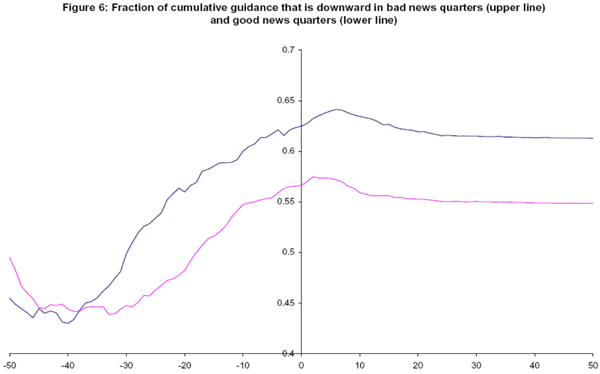In the June 2005 update of their paper entitled “Is Guidance a Macro Factor? The Nature and Information Content of Aggregate Earnings Guidance”, Carol Anilowski, Mei Feng and Douglas Skinner investigate whether aggregate management earnings guidance predicts future aggregate earnings news and overall stock market returns. Using a sample of 31,320 annual and quarterly management earnings forecasts for 1994-2003 from Thomson First Call, they find that:
- The proportion of firms issuing earnings guidance increases from less than 10% in the mid-1990s to around 25% in the early 2000s. Value-weighted percentages are higher.
- Over half of all quarterly earnings guidance is downward, with the remainder equally divided between upward and neutral. The ratio of downward to upward guidance varies considerably from quarter to quarter.
- Companies tend to issue neutral guidance early in the quarter, downward guidance toward the end of the quarter, and upward guidance after the end of the quarter. Investors therefore have a good idea by the end of a quarter of the overall extent of bad news.
- The fraction of downward quarterly guidance is potentially informative about aggregate earnings news (see “Figure 6” below from the paper). The information value of guidance increases during the quarter, causing the overall impact of guidance to become more negative as the quarter progresses.
- Aggregate earnings guidance does not predict quarterly market returns. There is modest evidence of a negative correlation between monthly changes in the fraction of downward guidance and monthly market returns, but guidance seems to lag returns.
- Positive market returns in good news quarters tend to accrue smoothly; negative market returns in bad news quarters concentrate (along with the negative guidance) in the last few weeks of those quarters. (See “Figure 5” below from the paper.)
- Earnings guidance issued by the largest firms relates to overall market returns in short windows around releases.
The following chart, extracted from the paper (and annotated), illustrates the effect of the concentration of downward guidance near the ends of quarters.

The next chart, also extracted from the paper, illustrates the potential informativeness of the proportion of downward earnings guidance. Bad and good news quarters are defined as in “Figure 5” above.

In summary, while there is a weak negative correlation between aggregate downward earnings guidance and monthly stock market returns, the stock market probably leads the guidance.